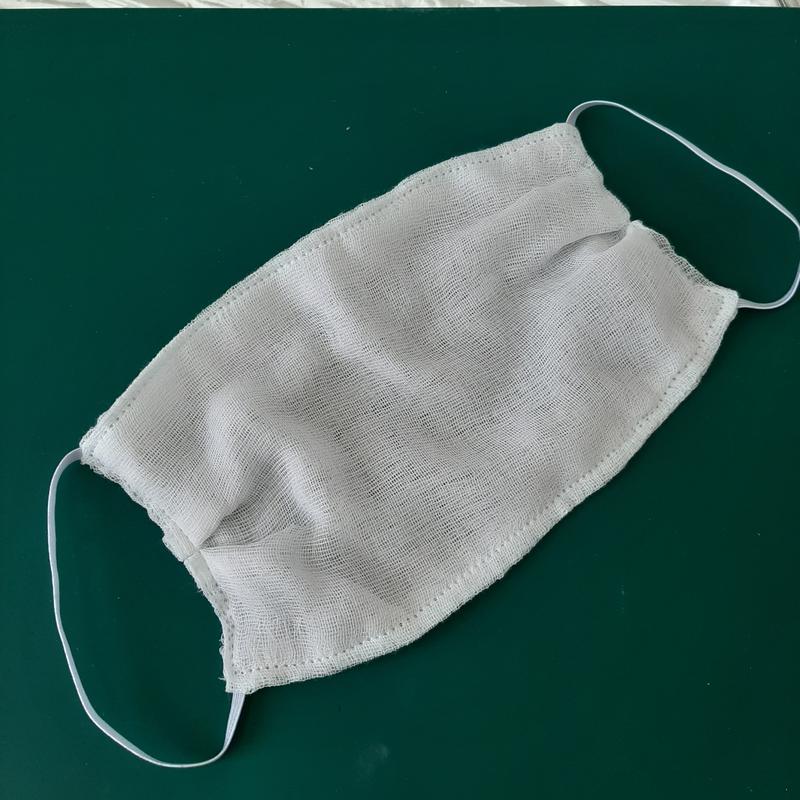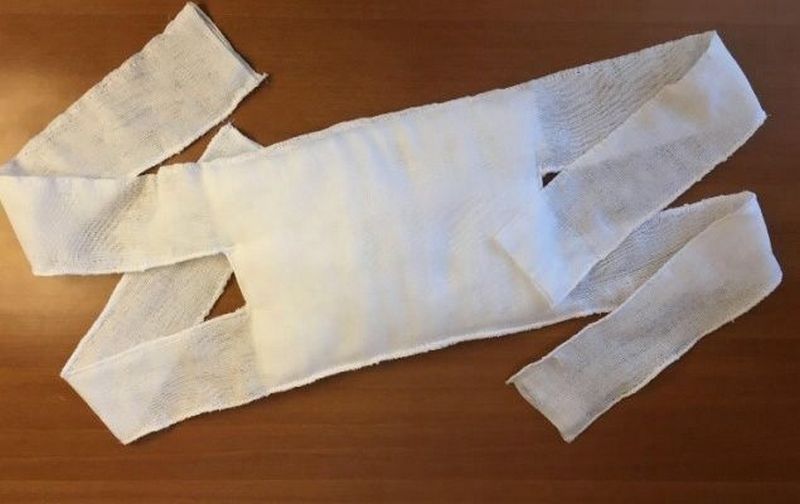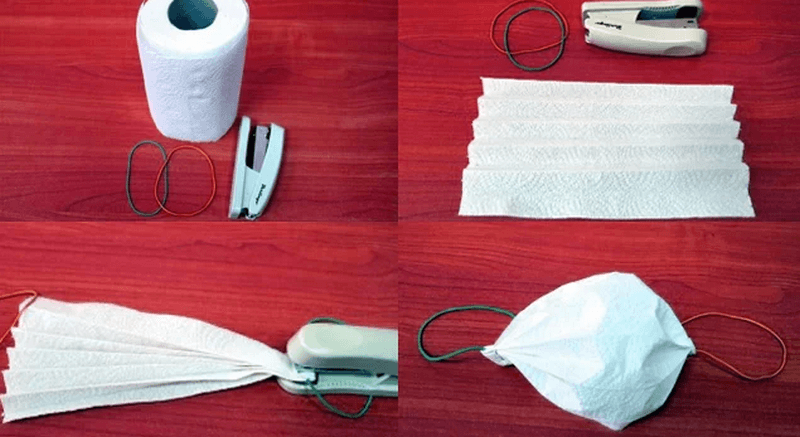To prevent the incidence of viral infections, you must regularly wash your hands, use antiseptics, and wear medical masks.
Leave the apartment preferably in a medical mask (and if it is not, cover your nose and mouth with a scarf or handkerchief). But it is sometimes almost impossible to find ready-made medical masks in pharmacies. Fortunately, it is very easy to sew a mask yourself.
We will explain and show in our simple lessons how to sew masks yourself: those that can be sterilized (they are suitable for hospitals, nursing homes, and so on), and simpler ones for daily use.
How to sew a reusable medical mask
The main feature of this mask is that it is completely made of cotton, it can be sterilized (boiled or washed at 90 degrees).
To make it, you need a square piece of cotton fabric measuring 20 by 20 centimeters and two strips of the same fabric 1 meter long and 3.5 centimeters wide each.
Tailoring algorithm:
- at the top and bottom of the future mask, bend the square of fabric by 0.5 centimeters, iron and sew;
- according to the pattern (see attached PDF file with the pattern of the mask) make incisions on the sides of the square to help fold the mask. Fold the square with an accordion according to the scheme from the video, iron it, fix it with pins;
- for future ribbons: bend the edges inside each of the long strips along the entire length with an indent of 0.5-0.7 cm, iron; fold the resulting strips in half, iron again;
- insert the cloth folded for the mask in the center of these strips, hiding the raw edge in them, and secure it with pins;
- secure the tie strips with pins along the entire length;
- stitch the ties.
To simplify the work, you can use 100% cotton braid instead of long strips of fabric.
How to sew a medical mask for daily wear
This mask is easier to sew and easier to wear, but it can not be sterilized, you can only carefully wash it, because instead of tape, elastic bands are used here. But it is two-layer. You can also sew a single-layer version: this mask will be less effective, but it will be easier to breathe through it.
To make it, you will need two squares of cotton fabric measuring 20 by 20 centimeters, two rectangles of the same fabric measuring 11 by 3.5 centimeters, and two pieces of underwear elastic 17-22 cm long, depending on the size of the head (for a children's mask — 11-14 cm). The mask pattern in PDF is here.
Tailoring algorithm:
- fold the squares of fabric facing each other. Stitch two opposite sides at a distance of 1 cm from the edge;
- turn out on the front side, iron the stitched edges;
- make cuts on the free edges in accordance with the pattern, fold the accordion, as shown in the video, iron, secure with pins;
- bend the side strips from the short sides by 1 cm, from the long ones — by 0.5-0.7 cm, iron them, fold them in half lengthwise and iron them again;
- put the cloth folded for the mask in the middle of the side strips, hiding the raw edge in them, insert the ends of the elastic band with a small margin in the corners, secure with pins;
- stitch the side stripes.
Gauze mask
Everyone probably has gauze at home. It is better to take a good four-layer gauze (if there is no such thing, you can just fold a large piece of fabric four times). To fix the mask, you need to use a sewing elastic band.
There is nothing complicated in sewing a medical mask with your own hands. All tools are available to everyone, materials will be found in the first-aid kit or in the toolbox.
Tailoring algorithm:
- cut a rectangle with sides 20 by 30 cm out of gauze (we remind you, four-layer), fold it in half and put a small layer of cotton wool;
- stitch the edge using the back needle method, and then sweep it so that the gauze does not crumble;
- turn out the blank and carefully consider: you should get a bandage of 8 layers;
- after that, the side part is divided into 4 parts as follows: fold the rectangle vertically in half and mark the middle with a pencil or needle, then fold it horizontally in half and mark it again. It turned out 4 smooth parts. Make all markings on the wrong side;
- to make it comfortable to wear, you need to make a counter fold (as on masks from the pharmacy), moving the extreme pins to the middle;
- the mask is almost ready, it remains to fix two elastic bands. The length of the elastic bands is about 12 cm, but it is better to measure for your head, so that it is convenient;
- the ends of the cut elastic bands are placed inside the workpiece and carefully sewn together with the fold.

The gauze mask is ready and can be used as intended. As you can see, it is not difficult to make a mask from gauze with your own hands.
Bandage mask
If there is no gauze, do not worry, you can use a roll of bandage. The manufacturing methods are similar, but the material and sewing algorithm are slightly different.
The bandage is the main material that we will use. Bandages come in different widths. It is better to choose a bandage width of 14 cm you also need to carefully read the composition: it should not contain any synthetic substances.
The second important element is cotton wool, which will act as a filter. Only natural cotton material should be used. Synthetic wool is not suitable for the mask. To determine whether the cotton is natural or not, you need to use ultraviolet light: if it glows, it has synthetic fibers in it. The length of the fibers should be large, short fibers will get into the respiratory system of a person. This is easy to check: you need to shake a piece of material, if there is dust, then the cotton wool is not suitable for the mask.
As a tie, you can use a sewing elastic band or a piece of the same bandage. The most practical and easy option will be with an elastic band: a person can remove and put on the mask without touching its central part.
All parts can be sewn using a sewing machine or manually.
Before sewing, you need to determine the size of the mask. For an adult, you need a square with a side of 14 cm. The bandage is folded in 3-4 layers, so for this square you need to measure 60 cm of the bandage.

If the standard size does not fit, you can make individual measurements. to do this:
- unwrap the bandage and apply it from one ear to the other - this will be the width of the future product;
- be sure to leave 1-1. 5 cm to sew the parts and stitches;
- the same distance must be multiplied by 3-the central part;
- the length of the tie is measured by the length of the circumference of the head, which is measured using a centimeter or thread.
The child mask will consist of a rectangle with sides 10 cm and 14 cm.
Before working, you need to slightly sew on the elastic bands and check whether the product is firmly held on the face. If the elastic bands are weak, the excess is cut off. It is necessary to pay attention to the preparatory stage, so as not to waste time in vain.
Paper mask
If the first-aid kit is empty, and the finished mask is needed urgently, you will need a method for making a mask from paper. To do this, you will need paper towels, multi-layer paper or, in extreme cases, toilet paper. It is important that you can easily breathe through the material. This, of course, is not the best option, but it will be enough to travel on public transport for 15 minutes.
The materials for the mask remain the same, except for the main material - here it is paper. Do not forget to make the necessary measurements and try on before attaching the elements.
There are several types of paper masks, we will consider a universal algorithm:
- the paper towel sector is folded like an accordion. The denser the material, the better the effect, but if the paper is very dense, it will be difficult to breathe;
- elastic bands are attached to the edges of the bandage.

Important: the mask is disposable and will last for several minutes. But this is a cheap and fast option to go, for example, to the store.
If you only have wet wipes, you can dry them with a hair dryer. In this case, you do not need any other materials, just take so many napkins that the width of the mask satisfies you. In the middle, you can make a filter out of cotton wool.
This is how you can quickly make a mask with your own hands without a sewing machine.
How to wear a mask correctly
First of all, you need to wash your hands thoroughly. Special attention should be paid to the spaces between the fingers. Do this all preferably in warm water and always with soap.
The following rules must be observed When putting on the mask:
- the mask must be carefully examined (it may have dirt, dust, or something similar);
- the sides of the home mask are the same, so we choose any one and start putting it on;
- carefully put it on and fasten it on the ears;
- adjust the mask so that it fits snugly to the face, to do this, it must be spread wide;
- the main rule is not to touch the main part, you only need to take the strings.
These are the main requirements for putting on a mask. When using it, you need to carefully monitor that it does not move to the side and does not open areas of the face.
You can't wear a mask for more than two hours, because the barrier material is moistened and heated by human breath. This creates an ideal environment for bacteria. A sick person needs to change the mask when it gets wet from nasal discharge or from breathing. Healthy people also need a mask, but only if they are in crowded areas or in contact with people who have signs of a viral disease.
Reusable masks should be washed with washing powder after each outdoor activity, preferably with boiling, and then ironed before use.
It is strictly forbidden to wash, iron, and then wear disposable masks.



